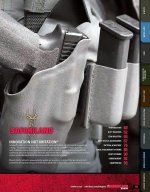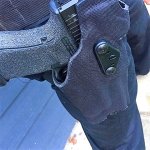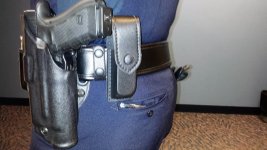Dang! I'm not smart enough to understand the OP's point. For the last many years my carry pistols have all been striker fired with no external safeties. I've looked at all my holsters for these firearms (the ones I use are mostly made of kydex) and I can not see a way that any object could actuate the trigger of my pistols while holstered.
I do carry AIWB. Never carry with a light attached (or anything else). So what is the greater risk?
Is your greater concern the location of carry, striker fired pistols or the design of the holster?
It is a struggle for some, perhaps many, and I reckon at least partly because there are several issues being mixed together; and when one issue is 'successfully' defended, then some may think 'all problems solved'.
First: AIWB, when taken
literally, means the pistol is being carried at about 1:00 because that's where the appendix is. In this position the wearer is muzzling himself when seated. Well, if all the pistols before the Glock was introduced couldn't be carried this way without violating the first rule of gun safety, be assured that Glocks can't be either.
People can, and do, decide to carry this way anyway; it's not what my post is about; but you asked.
Second: AIWB, when taken
historically, means the pistol is being carried at about 2:00. In this position the pistol can be carried without muzzling even when the wearer is seated,
when the muzzle is angled to the
rear.
Again, not what my post is about.
Third: holsters can increase the safety (I'm not referring to security/retention; but to safety) of carrying a pistol, when the pistols have moveable external parts. These include double action triggers, external hammers, grip safeties, thumb safeties -- by interfering with their movement into a firing position (such as a rising or falling hammer) AND not interfering with their operation.
On the other hand, straps have been known to enter the guard during holstering, and have been known to switch off thumb safeties, and have been known to depress grip safeties (across-the-grip straps).
Fourth: holsters can affect (I didn't say 'effect' and I didn't say 'increase') the safety of carrying a pistol, by covering the trigger guard. This has been done / not done since there were holsters mid-1800s. Holsters today generally include covered guards but there are plenty of designs that leave the trigger exposed; depends on the design of the pistol, doesn't it? Modern replicas of the famous Threepersons holster for revolvers are plentiful, and have a fully exposed trigger and guard.
Covered guards can inhibit, and even absolutely prevent, a third party from pressing the trigger. But they can also cause the trigger to be depressed: a finger in the guard whilst holstering, something else caught in the guard whilst holstering, catching on the edges of a trigger shoe (not much used today but a significant trouble once-upon-a-time).
My post was partly about how the use of lights caused gaps at the covered guard, near the trigger, and the holster makers didn't notice until after the accidents began. It's my view that they, and their consumers, made an assumption that covering the guard created, ipso facto, safety. It didn't. Instead it
added a risk and I gave examples of real-life situations.
Fifth: striker pistols, whether an early 20th century Colt .25 or an early 21st century Glock, don't have a hammer to block up or down. Now the
holster maker is helpless to incorporate a feature into his product, that will provide the additional safety level that he does for
all other forms of pistol.
So regardless of the consumer's confidence in his pistol and his holster maker, there is one less safety feature available for a holstered Glock (as an example of a striker pistol), than there is for
any other pistol. And it CANNOT be included: blocking the hammer.
Sixth: stealthily the 'perfect storm' of (1) no hammer to block, (2) use of lights that are bigger than the width of the trigger guard, and (3) carrying at 1:00 or 12:00 or 11:00, has formed; and all three began, and then combined, during this century.
And from the arguments received, not a lot of people have noticed. And that's what I want them to do: notice, because once they work out the physics involved, they'll realise that their reasoning will not compensate for the physics.







